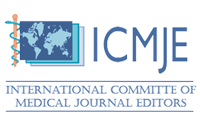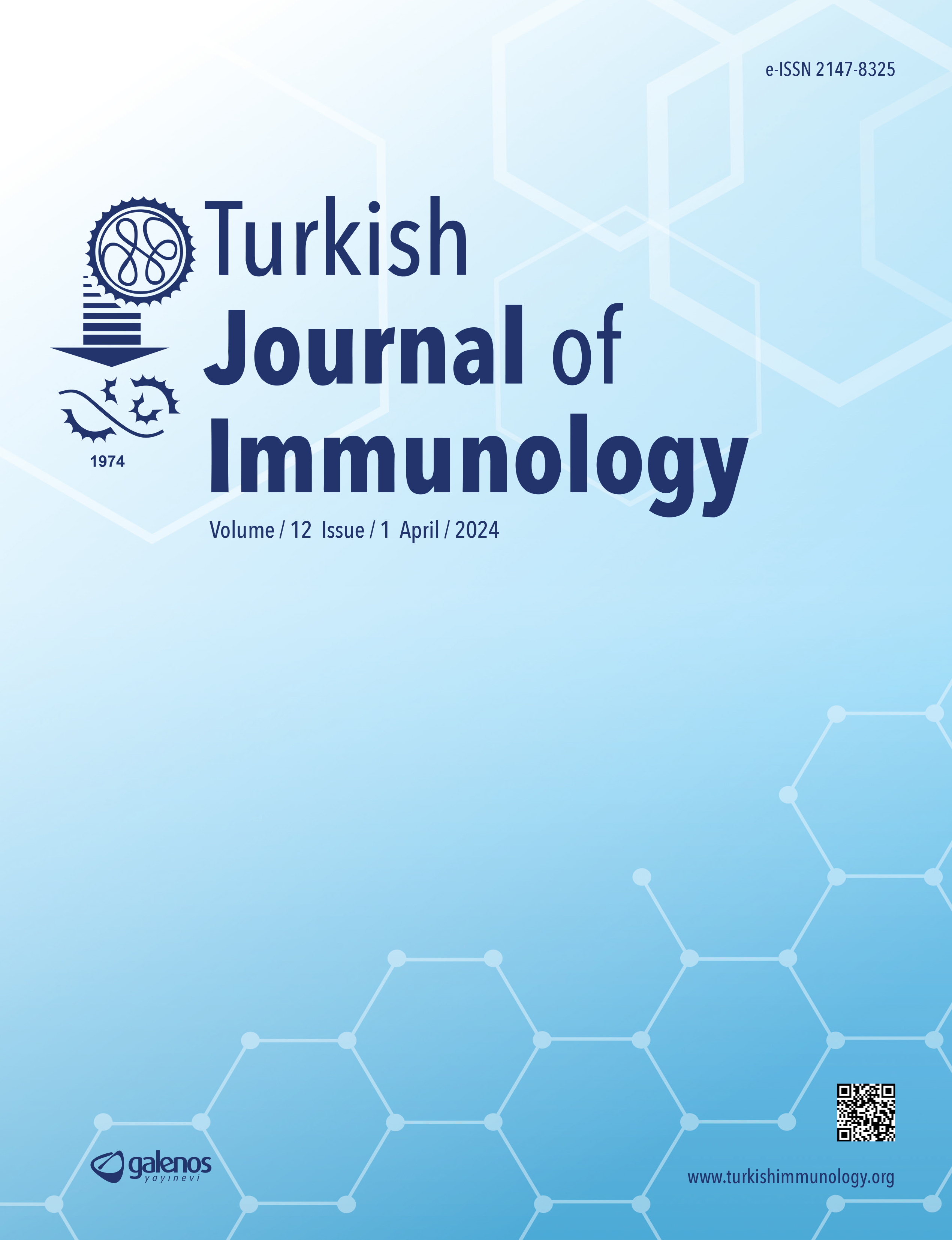Index








Applications



Membership



Volume: 9 Issue: 2 - 2021
| 1. | Cover Page I |
| 2. | Advisory Board Pages II - IV |
| 3. | Publication Policies and Writing Guide Pages V - VIII |
| 4. | Contents Pages IX - X |
| 5. | Editorial Page XI |
| REVIEW ARTICLE | |
| 6. | Recombination Excision Circle (KREC) Immunoglobulin Gene Rearrangement Mechamism and Importance in Transplants Zeynep Akbulut, Gulderen Yanikkaya Demirel doi: 10.5222/TJI.2021.40085 Pages 59 - 66 Kappa hafif zinciri dairesel kesip çıkaran immünglobulin gen yeniden düzenlenme mekanizması (Kappa deleting recombination excision circle-KREC), B lenfositlerinin, çok farklı çeşitlilikteki antijenlere karşı immün sistemi korumada göstermiş oldukları özgül yanıt sonucunda meydana gelen moleküler bir yapı olup, özellikle immün yetmezliği olan hastalarda erken immün yanıtın göstergesi olarak değerlendirilmektedir. Kemik iliğinden B hücresi çıkışını göstermek için moleküler analiz yöntemleri ile KREC ölçümü yapılabilmekte ve konu ile ilgili klinik çalışmalarda son yıllarda artış görülmektedir. Bu derleme, KRECin oluşum mekanizması, KREC ölçümünün önemi ve hastalıkların tedavisindeki yerinin ne olduğunu açıklamaya odaklanmıştır Kappa deleting recombination excision circle (KREC) is a molecular structure that occurs as a result of the specific response of B lymphocytes to protect the immune system against a wide variety of antigens and is considered to be an indicator of early immune response, especially in immunodeficiency disease patients. KREC can be measured with molecular analysis methods to show B cell output from the bone marrow and there has been an increase in clinical studies on the subject recently. This review is focused on explaining the mechanism of KREC occurrence, the importance of KREC measurement and its role in the treatment of diseases. |
| 7. | The Importance of Vitamins A, C, and D in the Pathophysiology of SARS-CoV-2 Fatma Şengül, Ali Şahin, Fatma Akat, Hüsamettin Vatansev doi: 10.5222/TJI.2021.57966 Pages 67 - 79 Şiddetli akut solunum sendromu koronavirüs 2nin (SARS-CoV-2) neden olduğu devam eden koronavirüs hastalığı pandemisi (COVID-19), Çinde ortaya çıktı ve hızla tüm dünyaya yayıldı. Her gün binlerce vaka ve ölüm rapor edilmektedir ve birçok hasta için acil müdahalenin gerekli olduğu istisnai bir durumdur. COVID-19 vakaları her yaş grubunda görülmekle birlikte ölüm oranları özellikle bağışıklık sistemi zayıflamış olan yaşlılarda, kronik hastalığa sahip olanlarda, immün yetmezliğe neden olan kanser vakalarında yüksek olmaktadır. Enfeksiyonlar ve bağışıklık sistemi arasındaki etkileşim açıktır ve pek çok literatür bilgisi mevcuttur. Bağışıklık sistemini güçlü tutarak enfeksiyonlar daha az hasarla atlatılabilir, inflamasyonun zararlı etkileri ve ölüm oranları azaltılabilir. A, C ve D vitaminleri bağışıklık sisteminin aktif işleyişinde etkilidir ve eksiklikleri başta enfeksiyonlara yatkınlık olmak üzere birçok olumsuz duruma neden olur. COVID-19 tedavisi için spesifik bir tedavi yöntemi, antiviral ilaç veya güvenilirliği kanıtlanmış aşı bulunmamakla birlikte Dünya Sağlık Örgütünün önerdiği ilaçlar kullanılmaktadır. Bu ilaçların etkinliği ve verimliliği tartışmalıdır. Bu ilaçlara ek olarak alternatif tedavi yaklaşımlarına ihtiyaç vardır. Bu derlemede, A, C ve D vitaminlerinin SARS-CoV-2 patofizyolojisindeki önemi ve COVID-19 tedavisinde alternatif yaklaşımlar olan yüksek doz intravenöz (IV) C, oral A ve D vitaminlerinin erken dönemde uygulanması ile ilgili bilgiler derlenmiştir. The continuing pandemic of coronavirus disease (COVID-19), caused by severe acute respiratory syndrome coronavirus 2 (SARS-CoV-2), was emerged in China, and has spread rapidly all over the whole world. Thousands of cases and deaths reported each day and it is an exceptional situation in which emergency response is required for many patients. While COVID-19 cases are seen in all age groups, death rates are high in cases of cancer that cause immunodeficiency, especially in elderly people with impaired immune systems, in those with chronic diseases. The interaction between infections and the immune system is clear and there is a lot of relevant literature information. By keeping the immune system strong, infections can be overcome with less damage, and the harmful effects of inflammation and death rates can be reduced. Vitamins A, C and D are effective in the active functioning of the immune system, and their deficiencies have many adverse conditions, particularly susceptibility to infections. Although there is no specific treatment method, antiviral drug or vaccine with proven reliability for the treatment of COVID-19, the drugs recommended by the World Health Organization are being used. The effectiveness and efficiency of these drugs are controversial. In addition to these drugs, alternative treatment approaches are needed. In this literature review, the importance of vitamins A, C and D on the pathophysiology of SARS-CoV-2 and on the early-stage administration of high-dose intravenous (IV) C, oral A and D vitamins, which are alternative approaches, in the treatment of COVID-19 is shared |
| ORIGINAL RESEARCH | |
| 8. | mRNA Expression Levels of NKp30, NKp46, NKG2D, Perforin and Granzyme in the Behçets Disease Metin Yusuf Gelmez, Suzan Çınar, Esin Aktaş, Fatma Betül Öktelik, Goncagul Babuna-kobaner, Murat Erdugan, Ahmet Gül, Afet Akdağ Köse, Günnur Deniz doi: 10.5222/TJI.2021.03521 Pages 80 - 85 Amaç: Behçet Hastalığında (BD) Doğal Katil (NK) hücrelerinin immünregülatör etkisine yönelik sınırlı sayıda çalışma vardır. Bu çalışmada, aktif ve inaktif Behçet hastalarında NKp30, NKp46, NKG2D, perforin ve granzim mRNA ekspresyonları incelenmiştir. Gereç ve Yöntem: Çalışmaya 42 Behçet hastası ve 14 sağlıklı kontrol dahil edildi. NKp30, NKp46, NKG2D, perforin ve granzim mRNA ekspresyon düzeyleri RT-PCR ile, CD3+ T ve NK hücreleri akan hücre ölçer ile analiz edildi. Bulgular: Hasta ve sağlıklı kontroller arasında NKp30, NKp46, NKG2D, perforin ve granzim mRNA ekspresyon düzeyleri açısından anlamlı bir fark saptanmadı. Aktif hastalarda CD3-CD16+CD56dim NK hücre oranları ile NKG2D ve NKp46 mRNA ekspresyon seviyeleri arasında, inaktif hastalarda ise CD3+ T hücre oranları ile NKp46 mRNA ekspresyonları arasında pozitif korelasyon saptandı. Sonuç: NKp30, NKp46, NKG2D, perforin ve granzim mRNA ekspresyonları açısından anlamlı fark bulunmamakla birlikte bu moleküllerin Behçet patogenezindeki potansiyel rolünü dışlamak için daha fazla fonksiyonel çalışma gereklidir. Objective: There are limited studies about NK cells that may have an immunoregulatory role in Behçets Disease. NK cell receptor, perforin and granzyme mRNA expressions were analyzed in both active and inactive BD patients. Materials and Methods: NKp30, NKp46, NKG2D, perforin and granzyme mRNA expression were analyzed in 42 patients with Behçets disease and 14 controls by RT-PCR. CD3+ T, and NK cell subsets were analyzed by flow cytometry. Results: NKp30, NKp46, NKG2D, perforin and granzyme expression levels between patients and healthy subjects did not show any significant differences. However, a positive correlation was detected between CD3-CD16+ CD56dim NK cell frequencies and NKG2D and NKp46 mRNA levels in active BD patients and between CD3+ T cell frequencies and NKp46 mRNA levels in inactive Behçets patients. Conclusion: Although, a significant difference does not exist between NKp30, NKp46, NKG2D, perforin and granzyme mRNA expressions, further functional studies are necessary to rule out the potential role of these molecules in the pathogenesis of Behçets Disease. |
| 9. | Intracytoplasmic and Plasma Cytokine Levels of Natural Killer Cells in Patients with Asthma Nilgün Akdeniz, Esin Çetin, Gaye Erten Yurdagül, Vuslat Yılmaz, Bilun Gemicioglu, Günnur Deniz doi: 10.5222/TJI.2021.42714 Pages 86 - 94 Amaç: Doğal öldürücü hücreler, kronik inflamatuvar havayolu hastalıklarının patogenezinde immünomodülatör rol oynamaktadır. NK hücreleri, tip 2 sitokinlerin üretimini artırarak alerjik havayolu iltihabına neden olabilmektedir. Gereç ve Yöntem: Yeni teşhis edilmiş (YT) astım hastalarında, tedavi altındaki (TA) astımlı hasta ve kontrol örneklerinde, NK hücre IL-13, IL-4, IFNγ ve IL-10'un intrasitoplazmik sitokin seviyeleri ve serumda IFN-γ, TNF-α, IL-2, IL-8, IL-4, IL-5, IL-6, IL-17, IL12, IL-13, IL-1β ve IL-10 seviyelerini akan hücre ölçer ve ProcartaPlex multipleks kiti kullanılarak değerlendirilmiştir. Bulgular: IFN-γ+ NK1 hücreleri her iki hasta grubunda da azalmıştır, her iki astımlı grup karşılaştırıldığında IFN-γ+ NK1 hücreleri TA astımlılarda daha yüksektir. NK hücrelerinin hücreiçi IL-4, kontrollere göre her iki hasta grubunda daha yüksektir. IL-10+ NK hücreleri, kontrollere göre her iki hasta grubunda daha düşüktür. TA astımlı ve kontrollere göre, YT astımlılarda IL-13+ NK2 hücrelerinin sayısının arttığı gözlenmiştir. Serumda, yeni tanılı astımlılarda TA hastalara karşı yüksek IL-1β seviyeleri bulunmuştur. Yeni teşhis edilmiş astımlılar, astımlılar UT ve kontrollere kıyasla daha yüksek IL-8 seviyeleri göstermiştir. Yeni teşhisli astımlılarda kontrollere göre daha yüksek IL-5 seviyeleri saptanmıştır. Yeni teşhisli astımlılarda diğer gruplara göre ve ayrıca TA astımlı hastalara kıyasla kontrollerde daha yüksek IL-13 seviyeleri tespit edilmiştir. IL-10 ve IL-12 seviyeleri, yeni teşhişli astımlılarda kontrollere göre azalmıştır. IL-2 seviyeleri hem astımlılarda hem kontrollerde düşük saptanmıştır. Sonuç: NK hücrelerini terapötik bir hedef olarak kullanmak için, her hastalıkta bu hücrelerin rolüne göre sitokin salgılama fonksiyonlarını düzenlemek amacıyla bir strateji oluşturulmalıdır. Objective: Natural killer cells play immunomodulatory role the pathogenesis of chronic inflammatory airway diseases. NK cells may induce allergic airway inflammation by increasing the production of type 2 cytokines. Materials and Methods: We measured intracytoplasmic cytokine levels of IL-13, IL-4, IFNγ and IL-10 in NK cells and serum levels of IFN-γ, TNF-α, IL-2, IL-8, IL-4, IL-5, IL-6, IL-17, IL12, IL-13, IL-1β and IL-10 in patients with newly diagnosed asthma, asthmatic patients under treatment (UT) and controls by using flow cytometry and ProcartaPlex multiplex immunoassays kit. Result: IFN-γ+NK1 cells were decreased in both patient groups; comparing both asthmatic groups, IFN-γ+NK1 cells were higher in asthmatics UT. Intracellular IL-4 of NK cells were higher in both patient groups vs. controls. IL-10+NK cells were lower in both patient groups vs. controls. We detected increased numbers of IL-13+NK2 cells in newly-diagnosed asthmatics vs. asthmatics UT and controls. In serum we found elevated levels of IL-1β in newly-diagnosed asthmatics vs. asthmatics UT Newly-diagnosed asthmatics showed higher IL-8 levels compared to asthmatics UT and controls. We showed higher IL-5 levels in newly-diagnosed asthmatics vs. controls. Higher IL-13 levels were detected in newly-diagnosed asthmatics vs. other groups and also in controls vs. patients with asthma UT. IL-10 and IL-12 levels were decreased in newly-diagnosed asthmatics vs. controls. IL-2 levels were low in both asthmatics vs. controls. Conclusion: In order to use NK cells as a therapeutic target, a strategy must be established to regulate its cytokine secretion functions with respect to their role of these cells in each disease. |
| 10. | Molecular Mimicry with Nsp11 Protein of SARS-CoV-2 in Individuals with HLA-B*15: 01 Allele Yekbun Adıgüzel doi: 10.5222/TJI.2021.58077 Pages 95 - 104 Amaç: Çalışmamızda SARS-CoV-2nin 13 amino asit uzunluğundaki yapısal olmayan protein 11 (Nsp11) proteininin belirli HLA serotiplerine sahip bireylerde otoimmün üzerinden reaksiyon oluşturma riski taşıyabilecek peptitlerinin varlığının araştırılması hedeflenmiştir. Gereç ve Yöntem: Bu amaçla, Nsp11 kaynaklı peptitlerin 12 insan lökosit antijeni (HLA) alleline bağlanma afiniteleri NetMHCcons ve NetCTLpan ile tahmin edildi. Kuvvetli bağlanan ya da epitop olarak tahmin edilen peptitler blastp ile insan proteomunda araştırıldı. Örtüşme bulunan peptidi içeren dizinin Nsp11 peptidi ile aynı HLA alleline kuvvetli bağlanması olup olmadığına aynı şekilde bakıldı. Bulgular: Nsp11 kaynaklı peptitlerin birinin HLA-B*15: 01 alleline kuvvetli bağlandığı ve diğerinin HLA-A*01: 01 alleline bağlanan sitotoksik T lenfositi (CTL) epitopu olduğu tahmin edildi. Peptitlerin blastp arama sonuçlarında immünoglobülin ağır zincir birleşme bölgesi (MOP92462.1) ile örtüşme sonucu üst bölgede gözlendi. Örtüşen peptidi içeren diziye ait bir peptidin HLA-B*15: 01 alleline bağlanan CTL epitopu olduğu tahmin edildi. Sonuç: Sonuçlar, HLA-B*15: 01 alleline sahip bireylerde SARS-CoV-2 enfeksiyonu otoimmün reaksiyon riskini artırabileceğini düşündürmektedir Objective: In our study, it was aimed to investigate the presence of peptides of the 13 amino acids-long non-structural protein 11 (Nsp11) of SARS-CoV-2 that may be associated with the higher risk of autoimmune reactions in individuals with certain HLA serotypes. Materials and Methods: For this purpose, the binding affinities of Nsp11-derived peptides to 12 major histocompatibility complex (MHC) supertype representative human leukocyte antigen (HLA) alleles were predicted by NetMHCcons and NetCTLpan. Strongly binding or predicted epitope peptides were sought in human proteome by blastp. Whether the sequence containing the overlapping peptide had a strong binding affinity to the same HLA allele as the Nsp11 peptide was also checked. Results: One of the Nsp11-derived peptides was predicted to be strongly bound to the HLA-B*15: 01 allele and the other to be the cytotoxic T lymphocyte (CTL) epitope that binds to the HLA-A*01: 01 allele. Alignment result with immunoglobulin heavy chain junction region (MOP92462.1) appeared on top within the blastp search results for peptides. A peptide of the sequence containing the overlapping peptide was predicted to be the CTL epitope that binds to the HLA-B*15: 01 allele. Conclusion: The results indicate that individuals with the HLA-B*15: 01 allele may have a risk of autoimmune reactions from SARS-CoV-2 infection |




